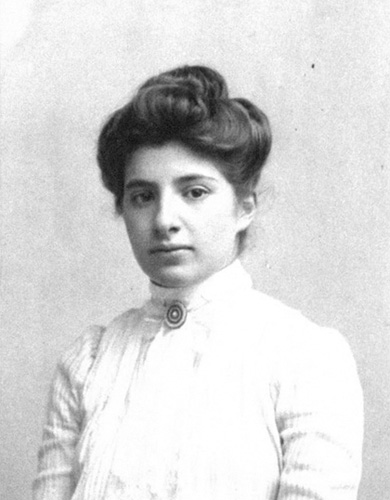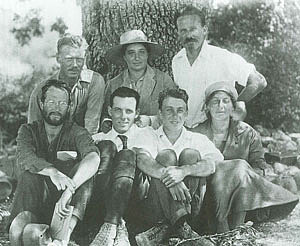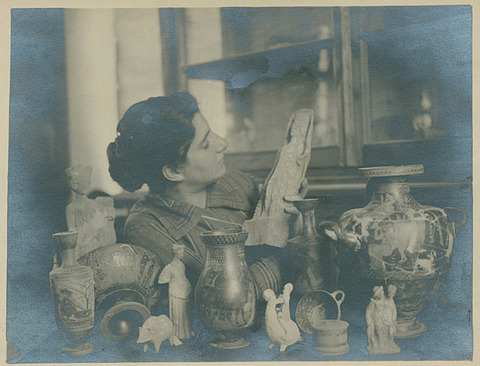Hetty Goldman: Life
Hetty Goldman was born December 19, 1881, in New York City, to a family of material and intellectual means. Her mother, Sarah Adler Goldman, was the daughter of the Rabbi of Temple Emanu-El in New York. Her father, Julius Goldman, was a lawyer whose father had founded the investment bank Goldman Sachs. Hetty Goldman and her three siblings attended the Sachs School for Boys and Girls, founded by their uncle Julius Sachs, who had studied Classics in Germany. A cousin, Paul Sachs, mentored a generation of American museum directors as a Professor at Harvard University and an influential Assistant Director of Harvard’s Fogg Museum.

In 1899, Goldman entered Bryn Mawr College, where she majored in Classics and English. Though Bryn Mawr had opened its doors only fourteen years earlier, archaeology had already taken hold. One of Goldman’s instructors had recently taken part in one of the first American excavations in Greece.
After graduation, Goldman continued study in Classics at Columbia University and also worked as a manuscript reader. She considered a career in writing, but found, she said, that she had “as yet nothing to say.” In 1906, she took a three-month tour of archaeological sites in Italy, and soon after she enrolled in Radcliffe College for graduate study in classical languages and archaeology. It was largely on the basis of her master’s thesis on Greek vase painting that she won the Charles Eliot Norton Fellowship to study at the American School of Classical Studies at Athens in 1910–11. She was the first woman to hold the fellowship, which was extended for a second year.
It was during a trip with the American School that her vocation as an archaeologist was confirmed. She wrote in 1918, “I cannot remember the exact process by which . . . I was transformed into a passionate excavator who was either turning up the soil of Greece, or planning to return to it; but complete conversion took place on top of a hill in Boeotia.” She had seen a mound that did not appear to be natural. It was the town of Eutresis, and in 1924 she would return to excavate it. However, in 1911 her attempts with Alice Leslie Walker, a fellow student, to obtain the American School’s permission to explore it were unsuccessful.
Walker and Goldman were, however, allowed to excavate another site they found, Halai on the Bay of Atalante, “a remote huddle of fishermen’s houses,” as Goldman described it, “by the waters of a blue and tranquil bay.” They were the third and fourth women to direct an excavation in Greece.
They found more than they expected to at Halai—beyond remains from the archaic and classical periods they found evidence of an underlying prehistoric village. Goldman would later say that the excavation of Halai gave direction to all of her future work, which delved more and more into prehistoric evidence.
The Balkan Wars in 1912–13 interrupted the excavation. During the wars, Goldman volunteered as a nurse in the Red Cross in Greece. Her sister, Agnes Goldman Sanborn, later noted that “Her experience with the peasant soldiers, who scarcely knew why they were fighting, left an indelible impression, and rendered her for all time peculiarly responsive to the appeal of suffering.”
When the First World War erupted in 1914, Goldman returned to Radcliffe, where she earned her Ph.D. in 1916. In the fall of 1918, she represented the Joint Distribution Committee for the Relief of Jewish War Sufferers in Greece, Serbia, Bulgaria, and Romania. She distributed funds, formed distribution committees among Jewish communities, and negotiated with governments to supply temporary housing to those whose homes had been destroyed.

After the war, now serving as a representative for the Fogg Museum, Goldman chose Colophon, a Turkish city then controlled by Greece, as the site of her second major excavation. Her team included Benjamin Meritt, who in 1935 would become the first historian appointed to the newly formed Institute for Advanced Study. However, after ten weeks the work at Colophon was also interrupted—this time by the Greco-Turkish War. When the team returned, the antiquities from the excavation, with the exception of inscriptions they had reburied, were gone.
Forced to return to mainland Greece, in 1924 Goldman began excavation of Eutresis, the mound that had intrigued her in 1911. Though later Goldman expressed dissatisfaction about not having further investigated the bottom layer of deposits, being “too timid about destroying anything,” the team made important finds that established the character of the pre-Mycenaean Bronze Age in Greece and formed the basis of later studies. Completed in 1927, Eutresis was the only of Goldman’s major excavations not to be interrupted by a war.
Goldman’s next and final excavation was of a hill in Tarsus, near the southeast coast of Anatolia, not far from Syria. It was her easternmost excavation. She later explained in a letter to Frank Aydelotte, the Institute’s second Director, “Nobody can study the prehistory of Greece without becoming aware almost immediately that the fecund breezes which blow out of the east were largely responsible for its early growth and development. So it is perhaps natural that a prehistorian sooner or later turns his eyes to Asia Minor for the solution to the problem of cultural origins in Greece and also for the study of the repercussions of prehistoric Greek culture upon the country from which it derived.”
In October 1936, a year into the excavation, Goldman received an invitation to join the Faculty of the Institute. She wrote to Abraham Flexner, the Institute’s founding Director, that after a discussion with Meritt she saw “the possibility of undisturbed work under conditions which certainly could not be equaled anywhere in America.” In addition to Meritt, she would be joining the archaeologist Ernst Herzfeld, also appointed to the Institute’s Faculty in 1936, who excavated in the Near East and who was interested in both ancient and Islamic sites. Goldman accepted the appointment with the understanding that she would spend half her time at the Institute and half in the field.
She did not convert easily to what she called “the contemplative life.” For the past twenty-five years she had spent much of her time on excavations, working from dawn to dusk, or searching for new prospects in Asia Minor and the Mediterranean, once escaping from bandits, once travelling four thousand miles in a Model A Ford with a minimum of five passengers and the occasional intoxicated local guide. She wrote to Flexner from Tarsus in 1938, “The excavation is my first love and fundamentally I fear I am a wandering spirit.”

During World War II, however, Goldman settled into life at the Institute, from which vantage she sponsored refugees from Europe. She returned to Tarsus in 1946–47, but it would be her last year of active excavation.
Goldman became Professor Emerita in 1947. She was still immersed in publishing material from Tarsus when a conference was held at the Institute in 1956 on the occasion of her seventy-fifth birthday and a festschrift was published in her honor. Ten years later, she became the second recipient of the Archaeological Institute of America’s highest award, the Gold Medal for Distinguished Archaeological Achievement. The award paid tribute, the citation stated, to “a perceptive and witty student of human relations, a renowned Anatolian specialist and the dean of Classical and Near Eastern archaeology in this country.”
Hetty Goldman died May 4, 1972, in Princeton, at the age of ninety. After her death, a former colleague recalled Goldman’s own explanation that, despite “inevitable drudgery,” the search for archaeological comprehension had been “like working my way through a dark tunnel with a light glimmering at the end, and gradually finding my way, by organization and comparative study, into the full light of a final arrangement that seemed to me valid.”
For additional information on Goldman’s work and legacy, please visit Hetty Goldman: Work and Legacy.